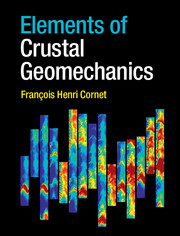Book contents
- Frontmatter
- Epigraph
- Contents
- Preface
- 1 Geomaterials and crustal geomechanics
- 2 Elements of rheology
- 3 Forces and stresses
- 4 Elements of kinematics
- 5 Elements of linear elasticity
- 6 From continuum mechanics to fluid mechanics
- 7 Elements of linear fracture mechanics
- 8 Laboratory investigations on geomaterials under compression 183
- 9 Homogenized geomaterials
- 10 Fractures and faults
- 11 Elements of seismology
- 12 Elements of solid–fluid interactions
- 13 Methods for stress field evaluation from in situ observations
- 14 Elements of stress fields and crustal rheology
- Appendix Elements of tensors in rectangular coordinates
- References
- Index
13 - Methods for stress field evaluation from in situ observations
Published online by Cambridge University Press: 05 April 2015
- Frontmatter
- Epigraph
- Contents
- Preface
- 1 Geomaterials and crustal geomechanics
- 2 Elements of rheology
- 3 Forces and stresses
- 4 Elements of kinematics
- 5 Elements of linear elasticity
- 6 From continuum mechanics to fluid mechanics
- 7 Elements of linear fracture mechanics
- 8 Laboratory investigations on geomaterials under compression 183
- 9 Homogenized geomaterials
- 10 Fractures and faults
- 11 Elements of seismology
- 12 Elements of solid–fluid interactions
- 13 Methods for stress field evaluation from in situ observations
- 14 Elements of stress fields and crustal rheology
- Appendix Elements of tensors in rectangular coordinates
- References
- Index
Summary
Stress is a continuum mechanics concept that supposes the existence of a representative elementary volume (REV) for the geomaterials of concern. Generally, the REV is small enough that the stress may be assumed to be constant within this volume.
Rock masses involve fractures and faults as well as continuous geomaterials, and the geometrical characteristics of fractures and faults are described by power laws which are not compatible with the definition of an REV. However, these power laws are valid within bounded domains.
The stress determination methods in geomechanics apply only to stress fields defined in continuous geomaterials and therefore it is assumed that no discontinuity exists within the volume of the measurement.
Geomaterials are very often elastoviscoplastic materials, i.e. they retain some memory of past loads for a while (chapter 2); efforts have been made to determine stresses from the monitoring of deformations that affect rock samples recently removed from their natural environment (e.g. Amadei and Stephansson, 1997, chapter 7). This supposes that such data depend only on the loading conditions that applied in situ to the samples before their extraction. However, in addition to the effect of stress boundary conditions, various sources of deformation exist, for example temperature variations or physicochemical interactions such as the swelling of clay or the subcritical growth of microcracks. Further, it has long been recognized that stresses exist within large blocks of rock even if these do not support any external load (e.g. Friedman and Logan, 1970); these stresses have been described as residual stresses. In order to avoid these difficulties, efforts have been concentrated on evaluating stresses from in situ measurements.
In this chapter we introduce various methods for stress determination from in situ measurements and in chapter 14 we present practical examples of applications. These examples illustrate how results obtained with different methods at the same site can provide confidence that the results are correct. They also shed some light on the rheology of rock masses at various scales, including the influence of faults and fractures.
- Type
- Chapter
- Information
- Elements of Crustal Geomechanics , pp. 369 - 398Publisher: Cambridge University PressPrint publication year: 2015

